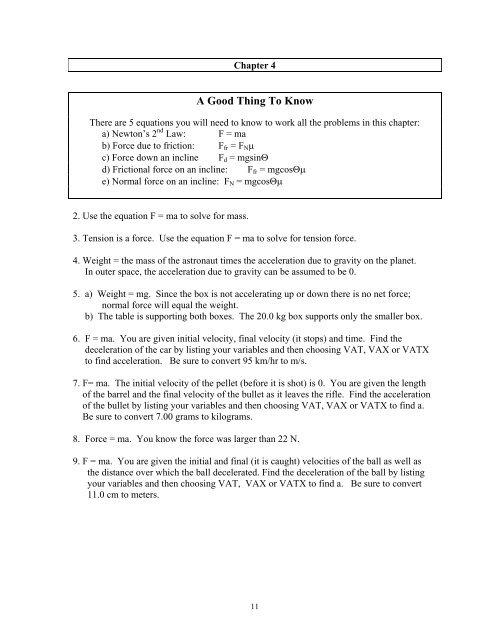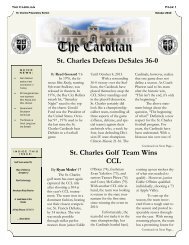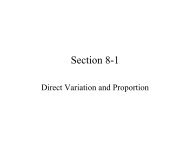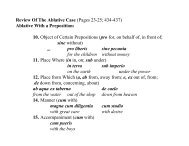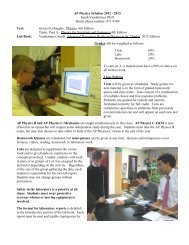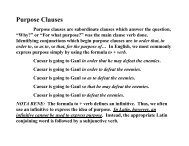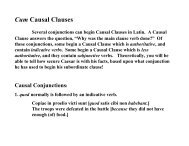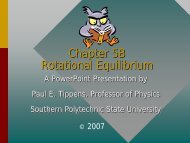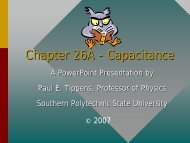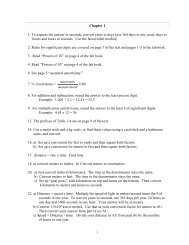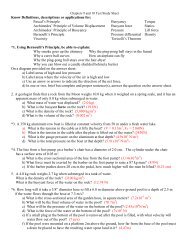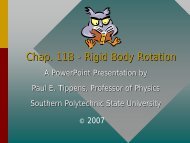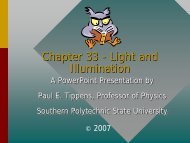Homework Hints Chapter 04.pdf
Homework Hints Chapter 04.pdf
Homework Hints Chapter 04.pdf
Create successful ePaper yourself
Turn your PDF publications into a flip-book with our unique Google optimized e-Paper software.
<strong>Chapter</strong> 4A Good Thing To KnowThere are 5 equations you will need to know to work all the problems in this chapter:a) Newton’s 2 nd Law: F = mab) Force due to friction: F fr = F N μc) Force down an incline F d = mgsinΘd) Frictional force on an incline: F fr = mgcosΘμe) Normal force on an incline: F N = mgcosΘμ2. Use the equation F = ma to solve for mass.3. Tension is a force. Use the equation F = ma to solve for tension force.4. Weight = the mass of the astronaut times the acceleration due to gravity on the planet.In outer space, the acceleration due to gravity can be assumed to be 0.5. a) Weight = mg. Since the box is not accelerating up or down there is no net force;normal force will equal the weight.b) The table is supporting both boxes. The 20.0 kg box supports only the smaller box.6. F = ma. You are given initial velocity, final velocity (it stops) and time. Find thedeceleration of the car by listing your variables and then choosing VAT, VAX or VATXto find acceleration. Be sure to convert 95 km/hr to m/s.7. F= ma. The initial velocity of the pellet (before it is shot) is 0. You are given the lengthof the barrel and the final velocity of the bullet as it leaves the rifle. Find the accelerationof the bullet by listing your variables and then choosing VAT, VAX or VATX to find a.Be sure to convert 7.00 grams to kilograms.8. Force = ma. You know the force was larger than 22 N.9. F = ma. You are given the initial and final (it is caught) velocities of the ball as well asthe distance over which the ball decelerated. Find the deceleration of the ball by listingyour variables and then choosing VAT, VAX or VATX to find a. Be sure to convert11.0 cm to meters.11
26. a) Draw the lawnmower and, using arrows, show all horizontal and vertical forces. Youmay not use any oblique lines.b) You have a push force and a retarding force (a combination of friction in the wheelsand against the ground) horizontally. Since the velocity is constant, the resultantforce = 0. The forward push force is equal to the horizontal component of the 88.0 Nforce directed along the handle. Use this information to solve for the retarding force.F(ret)Fp(x)c) The lawnmower has no vertical motion, so the vertical resultant force = 0. There arethree vertical forces acting on the lawnmower. These include the weight of the mower,the (y) component of the 88.0 N force directed along the handle pushing down and thenormal force pushing back up. Use this information to calculate the normal force on thelawnmower.d) This part of the problem must be solved in three steps.i) There is now a horizontal resultant force which = ma. The lawnmowerstarts from rest so the initial velocity will be 0. You are also given timeand final velocity. List your variables and choose from VAT, VAX orVATX to solve for the horizontal acceleration.ii) Use F = ma to find the resultant horizontal force using the resultantacceleration you just found. This resultant horizontal force is equal to thesum of the horizontal forces. (F res = F forward + F retarding ). You found theretarding force in part b, and that hasn’t changed. You also know theresultant force. Use this information to solve for the horizontal componentof the new forward push force.iii) The new horizontal push force is the x-component of the new forcedirected along the handle. Use trigonometry to find the new push force(the hypotenuse) along the handle.25. a) The top cord has 2 buckets hanging from it, so include both masses when you solve forthe tension in the cord. The bottom cord has only 1 bucket hanging from it. If thebuckets are at rest, there is no resultant force, and the tension up should be equal to thegravitational force pulling down..b) This is an elevator going up problem. See the homework hint for problem 12. Youwill have to solve this problem twice, once for each bucket.31. Use Example 4-20 on page 93.32. The vertical component in this triangle is acceleration due to gravity and the horizontalcomponent is given. Use trigonometry and find the angle.13
34. It will take 3 steps to solve this problem.i) The resultant force is due to gravity pulling on the two different masses. Gravitypulling on the heavier mass pulls down, but since a cord connects them, gravitypulling on the lighter mass resists. We are to ignore friction in this problem soF res = m 1 g – m 2 g, where F res = (m 1 + m 2 )a. Use this information to derive andequation for the acceleration of the system.ii) The lighter mass continues going up until gravity slows it to a stop.To find the maximum height the lighter mass reaches, we need to know themaximum velocity it had before the heavier mass hit the surface and gravity tookover. You found the rate of acceleration in the first part (i), you know thedistance the heavier mass traveled before it hit the surface, and you know thatinitially the two masses were at rest. List your variables and choose from VAT,VAX and VATX to solve for final velocity.iii) Use the final velocity you found in part ii) as your initial velocity for this laststep, because that’s how fast the lighter mass was also going when the stringstopped pulling it up and gravity started slowing it down. It will stop at the topof its trajectory (v = 0) and gravity will decelerate it. List your variables andchoose from VAT, VAX and VATX to solve for final velocity.36. If the crate moves at constant velocity, there is no resultant acceleration and no resultantforce. Set the two horizontal force vectors equal to each other and solve for the pushforce. For the second part of the problem, ask yourself how much force is necessary topush a box that does not resist.37. a) The minimum force necessary to get the box moving must equal the static frictionalforce keeping it in place.b) Since static friction is greater than kinetic friction, if the force to overcome staticfriction continues, only the smaller kinetic friction force will resist, and the box willaccelerate as a result. The resultant force = ma. The forward force = mgμ where μ =static friction, which you calculated in part (a). The resisting force = mgμ where μ =kinetic friction. The resultant force will equal the static frictional force (pushing) –kinetic frictional force (resisting).38. Convert 0.20 g to m/s 2 . The force holding you in place = F fr . It has to be equal to orless than the accelerating force.39. The force against which the tires push = F fr . It has to be less than or equal to the forwardForce, ma.40. The frictional force must be equal to or larger than the force down the incline.Set the two equal to each other and solve for the angle Θ.41. The resultant force down the incline, ma = Fd – Ffr.Find the frictional force using the equation for frictional force on an incline. Use that inthe above equation and solve for the coefficient of friction.14
43. a) Using arrows, show and label all the forces(there are 4) acting on the box.b) How would the length of the arrows change if there were a resultant force down?c) How would the length of the arrows change if there were a resultant force up?30 o44. You are given variables for initial velocity (it starts from rest) and distance Choose fromVAT,. VAX or VATX to solve for acceleration. Since the car is moving at maximumacceleration without slipping, the resultant forward must exactly equal to the resistingstatic friction force. Use that information to solve for μ.47. The frictional force that stops the box must equal the force (F = ma) that pushed the box.Use this information to solve for acceleration. You are given variables for initialvelocity, and final velocity (it stopped), and you solved for a initially. Choose fromVAT, VAX or VATX to solve for Δx, which is the distance over which the box willstop.48. The two crates have the same horizontal acceleration and no vertical motion.F res = (m 1 +m 2 )a.push forcem m 1 2(a) (b)a) m 1 has 3 horizontal forces acting on it; the push force, the resisting force from m 2and its own friction which also resists the push force.b) m 2 only has 2 horizontal forces acting on it; the resultant force left from m 1 and itsown friction force, which resists.49. The maximum decelerating force (F = ma) of the truck must be almost equal to the staticfrictional force that keeps the crate in place. Use this information to solve foracceleration.52. a) Force down, ma = mgsinΘ − the frictional force that impedes motion. Use thisequation to solve for acceleration.b) Now list your variables (including a) and choose from VAT, VAX or VATX to solvefor final velocity. Remember, it starts from rest.53. The force down the incline is due to gravity. It will slow the carton to a stop.Use ma = mgsinΘ and solve for acceleration. Now you have initial velocity, finalvelocity and acceleration. Choose VAT, VAX or VATX and solve for distance. Use thecalculated acceleration and distance in the time to fall equation to find the time up.Double that for the time to go up and then return to the starting point.15
54. The forces acting along the track on the roller coaster are gravity pulling down andfriction resisting. The sum of those two forces = the resultant force = ma. The forcedown = mgsinΘ. The resisting force = frictional force on a slant = mgcosΘμ. Don’tforget to make the resisting force negative when you add them. Use this information tosolve for a. Then list your variables for initial velocity (velocity at the top of the hill),distance and acceleration. Choose from VAT, VAX or VATX to solve for final velocity.55. You are given mass and acceleration, so you can find the resultant force (F = ma).Use F down = mgsinΘ. F res = F d - F fr and F fr = mgμ. Use that information to solve for μ.63. This problem is just like Example 4-20 on page 93, except now you have the force downthe incline on mass #1 resisting the gravitational force on mass #2.64. This is just like problem #63 except mass #1 has both the force of friction on an inclineand force down on an incline acting on it.67. This is just like problem #59 in chapter 2. F = ma. Calculate both force and distance.86. The tension in the cable has to equal the mass of the elevator plus the force necessary tostop the elevator.73. This is a flat surface, so you know the rate of deceleration is due to friction. You nowhave initial velocity, final velocity and acceleration. Choose from VAT, VAX orVATX and solve for distance to answer the first question. Once you fine distance,use VAT, VAX or VATX and solve for final velocity.79. This is just like problem 32, except this time you’re given the angle. Use the angle andthe vertical component to solve for the horizontal component of this triangle. Thehorizontal component is the acceleration of the jetliner. It starts from rest, you now haveacceleration, and the time is given. Choose from VAT, VAX or VATX and solve forfinal velocity.76. This problem is much like problem #31. You have m 2 , you are given the coefficient ofstatic friction and you know that when the bucket has the maximum amount of sand in it,the pull force must be exactly equal to the static frictional force.a) Using this information, calculate the m 1 . This is the mass of the sand and thebucket. This problem wants just the mass of the sand.b) Once the bucket starts to move, the resisting force is due to kinetic friction, whichis less than static friction and the bucket accelerates. Solve for the resultantacceleration.81. a) This is an elevator going up problem. The force on the rotors has to lift both thehelicopter and the frame.b) The cable only has to lift the frame.c) Use Newton’s 3 rd Law.16


